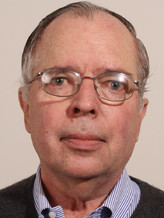Frank Paige, Senior Scientist Emeritus at Brookhaven National Laboratory (BNL), passed away on October 16, 2017 following a stroke. Frank was born on October 21, 1944 in Philadelphia and obtained his Ph.D. in Physics in 1970 from MIT under the supervision of Kerson Huang. He came soon thereafter to BNL as a postdoc, where he proceeded to spend his entire career, apart from a 2-year period, 1991-1993, when he was Senior Scientist at the SSC Lab in Texas.
Frank’s research interests included perturbative QCD, collider phenomenology, detailed simulation of events for high-energy pp, pbarp and e+e- interactions, supersymmetry phenomenology, and in later years, experimental collider physics. In 1979, when QCD was still in its infancy, Frank (with J. Kubar-Andre) was one of the first to correctly calculate the O(alpha_s) QCD correction to Drell-Yan processes, finding that the correction was significant. That same year, Frank (with S.D.Protopopescu) released the world’s first publicly available event generator for hadron colliders, ISAJET. Originally ISAJET was conceived to simulate jet production for the ISABELLE pp collider at BNL, which was eventually canceled. However it ultimately proved to be instrumental in the discovery of the W and Z bosons at CERN by UA1 and UA2, and was also used for most of the event generation for D0 for Run1 at the Fermilab Tevatron. Together with H. Baer and X. Tata, Frank expanded ISAJET in the early 1990’s to include supersymmetric particle cascade decays; they also built in 1994 the first public renormalization group code for calculating superparticle mass spectra, a part of ISAJET called ISASUGRA, and proposed collider exploration of the iconic m0 vs m1/2 plane of supergravity models.
In the 1980s and 90s, Frank was a leading figure in the US community in its deliberations over the future of high energy physics, serving, for example, as an editor on the influential 1982 Snowmass Study on future facilities. He studied signatures and backgrounds for a variety of physics processes for the SSC and lower energy hadron colliders, including signatures for the top quark, for Higgs bosons and for supersymmetric particles. Many of these studies went unpublished but diffused into the collective knowledge-base of the HEP community. Among the published studies, in a 1991 work with Bill Marciano, following the realization that the top quark was heavy, Frank was one of the first to propose a search for the Higgs boson in the ttH production mode, evidence for which has recently been announced by the ATLAS and CMS Collaborations at the LHC. In a 1997 paper with Ian Hinchliffe and other collaborators, Frank proposed the study of a variety of kinematical end points arising from invariant mass distributions to obtain supersymmetric particle masses in possibly complex cascade
decay chains.
Frank joined the ATLAS Collaboration at the CERN LHC following the demise of the SSC, working primarily in the SUSY and Jet/Missing ET groups. He was an early convener of the SUSY group, helping to develop many of the initial physics studies and projections. Frank plunged head-first into nitty-gritty details of experimental work, providing the first ATLAS jet energy calibration. Frank was a bit of a
software guru, though in his characteristic modesty, he would deny this. He is the author (with E. Myers) of TeXsis, a macro package for TeX. He was an early adopter of C++, and contributed to various aspects of the ATLAS event reconstruction and analysis software, as well as the search for the SUSY partner of the top quark.
Above all, Frank cared deeply about physics; he was driven by constantly trying to come up with new ideas, whether big or small, abstract or technical. He set a great example to younger people and was always generous with his time. Upon news of his death, there was a significant outpouring of memories and thoughts of gratitude from many colleagues, ATLAS and elsewhere. He leaves behind no immediate
family, but many of us came to believe that a little bit of him belonged to each one of us.
- His Friends and Colleagues

